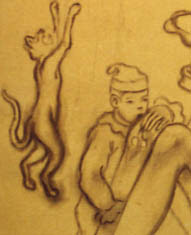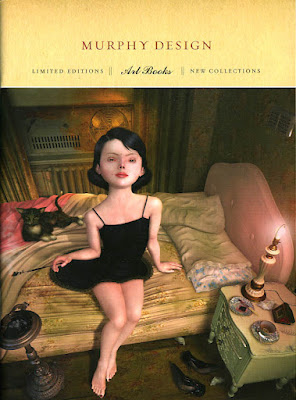 Small detail of sketch on canvas for Amy Crehore's Green Show painting
Small detail of sketch on canvas for Amy Crehore's Green Show painting Promotion booklet for Mark Murphy's Art Books (image copyright Ray Caesar)
Promotion booklet for Mark Murphy's Art Books (image copyright Ray Caesar)I am currently working on a large painting for the GREEN Show opening November 17th, 2007 at the Robert Berman Gallery (7pm-10pm) C2 Gallery Space, Bergamot Station, Santa Monica, CA. Here, I am showing you just a small piece of the larger image- sketched on canvas before I started adding color. I want this one to be a surprise, so I won't be unveiling it until the week of the show.
The GREEN Show is curated by Mark Murphy, a designer who publishes wonderful art books and calendars. Here is the cover of his promotional booklet featuring a fantastic painting by Ray Caesar, whose book is now available for pre-order at the Murphy Design site along with some other favorite artists.
Featured Artists in the GREEN Show: Jason D Aquino + Jordan Awan + Andrew Brandou + Cathie Bleck+ Marc Burckhardt + William Buzzell + Luke Chueh + David Chung + Amy Crehore +Kevin Christy + Sas Christian + John Copeland + Bob Dob + andrew foster+ Douglas Fraser + P-Jay Fidler + Joseph Daniel Fiedler + AJ Fosik + RobertHardgrove + Jody Hewgill + Michael Hussar + Tim Hussey + Jordin Isip + Rich Jacobs + Pamela Jaeger + james jean + David Choong Lee + Anthony Lister +Jen Lobo + Mars-1 + Chris Mostyn + Mark Murphy + Scott Musgrove + Christian Northeast + Martha Rich and Esther Pearl Watson Collaboration + Kathie Olivas + Nathan Ota + Brandt Peters + Jermaine Rogers + Kim Scott + Keith Shore + Jeff Soto + Damon Soule + Matt Stallings + Gary Taxali + Amanda Wachab + Justin Wood
Wow...what an incredible list. These paintings will all be fairly large works, each celebrating personal visions of nature. I will be flying down for the opening of this one.
P.S. Click on "Vote for me" if you like this blog.






